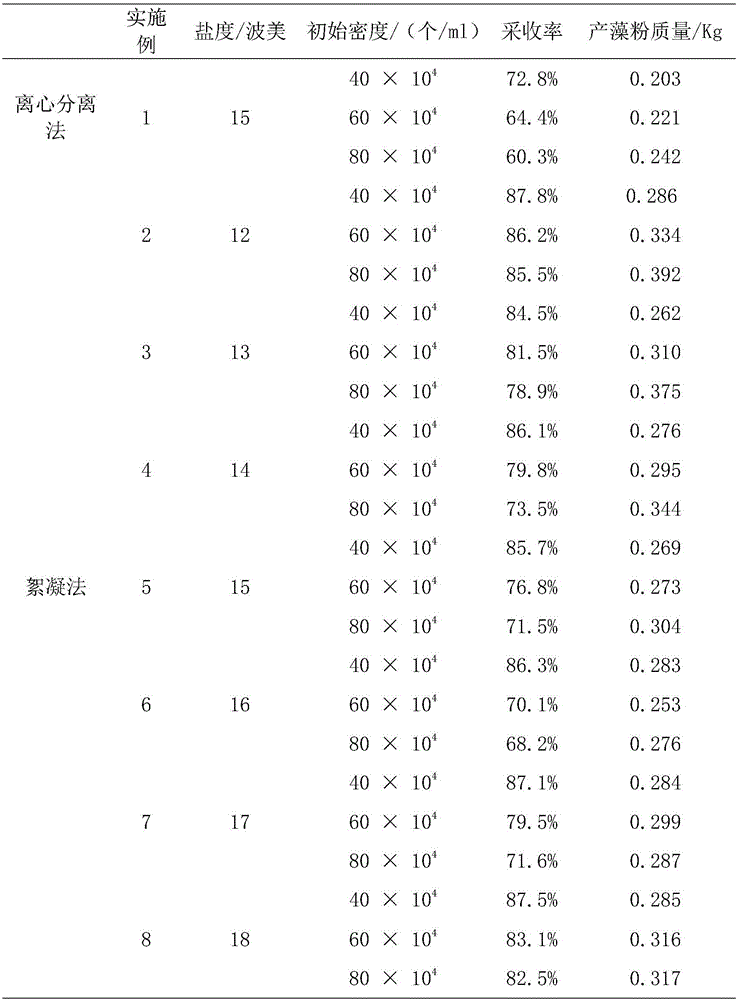Harvesting method of Dunaliella salina
A Dunaliella salina, harvesting method technology, applied in the direction of single-celled algae, isolated microorganisms, etc., can solve the problems of affecting the economic benefits of enterprises, large damage to algae cells, and low harvesting efficiency, and achieve a large amount of one-time processing and damage The effect of extreme degree and improvement of recovery efficiency
- Summary
- Abstract
- Description
- Claims
- Application Information
AI Technical Summary
Problems solved by technology
Method used
Image
Examples
Embodiment 1
[0069] Embodiment 1: The initial salinity of harvesting by centrifugal separation is 15 Dunaliella salina experiment
[0070] Experimental materials and equipment: necessary drainage pipes such as water pumps, tube centrifuges, blood counting boards, etc.
[0071] Experimental conditions: normal temperature and pressure
[0072] Algae fluid volume: 1.8m for each experimental treatment 3
[0073] The initial cell number of algal liquid: 40×104 cells / ml, 60×104 cells / ml, 80×104 cells / ml in the three tests of 1#, 2# and 3# respectively
[0074] Reaction time: 1.8 hours per test
[0075] Experimental results:
[0076] ①. The recovery efficiency is P1#=72.8%, P2#=64.4%, P3#=60.3%;
[0077] ②. The quality of algae powder produced is: M1#=0.203㎏, M2#=0.221㎏, M3#=0.242㎏
Embodiment 2
[0078] Example 2: Flocculation experiment of algae liquid with an initial salinity of 12
[0079] Experimental materials and equipment: the volume is 2m 3 3 vats (up and down with multiple drainage outlets) labeled 1#, 2#, 3#, analytical grade NaOH (≥99%), scales, blood counting boards and necessary drainage pipe devices
[0080] Experimental conditions: normal temperature and pressure
[0081] Algae liquid volume: 1.8m in each vat 3 ;
[0082] The initial cell number of algae liquid: 40×104 cells / ml, 60×104 cells / ml, 80×104 cells / ml in 1#, 2#, 3# tanks respectively
[0083] Added NaOH quality: 3.6kg per vat
[0084] Response time: 4 hours
[0085] Experimental results:
[0086] ① Floating or settling conditions: the algal flocculation in the three vats all settled;
[0087] ②. Recovery factor: P1#=87.8%, P2#=86.2%, P3#=85.5%;
[0088] ③. Quality of algae powder: M1#=0.286㎏, M2#=0.334㎏, M3#=0.392㎏
Embodiment 3
[0089] Example 3: Flocculation experiment of algae liquid with an initial salinity of 13
[0090] Experimental material and equipment: same as embodiment 2
[0091] Experimental conditions: close to Example 2.
[0092] Experimental results:
[0093] ① Floating or settling conditions: the algal flocculation in the three vats all settled;
[0094] ②. Recovery factor: P1#=84.5%, P2#=81.5%, P3#=78.9%;
[0095] ③. Quality of algae powder: M1#=0.262㎏, M2#=0.310㎏, M3#=0.375㎏
PUM
 Login to View More
Login to View More Abstract
Description
Claims
Application Information
 Login to View More
Login to View More - R&D
- Intellectual Property
- Life Sciences
- Materials
- Tech Scout
- Unparalleled Data Quality
- Higher Quality Content
- 60% Fewer Hallucinations
Browse by: Latest US Patents, China's latest patents, Technical Efficacy Thesaurus, Application Domain, Technology Topic, Popular Technical Reports.
© 2025 PatSnap. All rights reserved.Legal|Privacy policy|Modern Slavery Act Transparency Statement|Sitemap|About US| Contact US: help@patsnap.com



